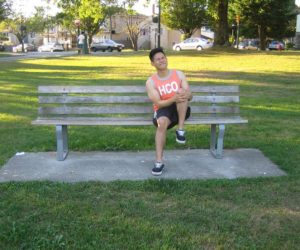Osgood Schlatter’s disease is a disorder that causes painful inflammation of the patellar tendon that is connected in the lower portion of the kneecap or patella to the shinbone or tibia. It causes a bony bump on the shinbone below the knee.
This condition usually affects young children especially in young adolescent boys participating in sports such as jumping or running. Boys ages 12-14 and girls 10-13 are susceptible to this condition. The condition disappears once the bones of the affected child stop growing.
Symptoms of Osgood Schlatter’s disease
- Pain at the tibial tuberosity or bony area on top of the shin below the kneecap.
- Inflamed and swollen
- Pain and tenderness of the area especially during and after exercises and subsides with resting.
- Pain in the area when performing squat type of exercises.
Causes

- The thigh muscles or quadriceps pull the tendon that attaches the kneecap to the growth plate above shinbone especially during playing volleyball, basketball soccer and ballet.
- Pain and swelling due to repeated stress on the area
Treatment
- Take plenty of rest especially the affected area. Avoid activities that cause pain for fast healing of the condition.
- Wear the prescribed patella knee strap to prevent further injury and worsen the condition. A patella strap or taping absorbs the shock or impact placed on the tendon. It lessens pain in the knee. Another alternative is using a neoprene knee support; it supports the joint and keeps the tendon warm.
- Apply an ice pack to the affected knee regularly especially before performing an activity or playing sports. Wrap ice compress in a towel before placing in the area for at least 10-15 minutes, 3 times every day. If pain is severe apply ice for 10 minutes every hour.
- Massage the area using ice.
- Compress the area using compression bandage such as ACE elastic bandage to lessen the swelling, the pain and support the affected area. Do not wrap too tightly to prevent issues with circulations. Loosen the wrap if the area under the wrap turns blue or violet.
- Take the prescribed anti-inflammatory medications to lessen the inflammation and the pain.
- Raise the affected above the heart to lessen the swelling and the pain. Raise the area in couple of pillows to ensure that it is elevated.
- Once pain subsides perform gentle stretching exercises, sports massage for the quadriceps and to stretch the muscles to be strong with the help of the physical therapist.
Tips
- Limit stressful activities or sports involving the knee such as volleyball, basketball, high jump and gymnastics.
- Proper stretching routine for the quadriceps and hamstring muscles before an activity to prevent Osgood Schlatter’s disease.
FACT CHECK
https://www.mayoclinic.org/diseases-conditions/osgood-schlatter-disease/symptoms-causes/syc-20354864
https://orthoinfo.aaos.org/en/diseases–conditions/osgood-schlatter-disease-knee-pain/
https://en.wikipedia.org/wiki/Osgood%E2%80%93Schlatter_disease